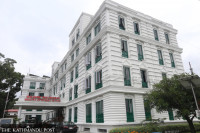National
Banks want to count 75 percent of federal grant to local units as deposit to maintain regulatory threshold
Banks are allowed to count up to 50 percent of such grant as deposit.
Prithvi Man Shrestha
The government and bankers are discussing allowing banks to count 75 percent of the grants that the federal government sends to the local governments’ bank accounts as deposits with most of the banks crossing the regulatory threshold of loan to deposit ratio.
Currently, the banks are allowed to count upto 50 percent of such grants as deposits.
Banks are required to maintain a loan to deposit ratio below 90 percent as per the Nepal Rastra Bank’s instruction. But, as the banks and financial institutions lent excessively while deposit growth stagnated during the first quarter of the current fiscal year, the loan to deposit ratio of most of the banks crossed 90 percent, leaving them unable to make further lending.
According to Nepal Rastra Bank Spokesperson Dev Kumar Dhakal, the loan to deposit ratio of most commercial banks has crossed the mandatory threshold.
This prompted banks to seek help from the government to ease the liquidity crunch. “In a recent meeting at the Finance Ministry, we asked the government to allow us to count 75 percent of the federal government’s grants to the local governments as deposits,” said Anil Kumar Upadhyay, president of Nepal Bankers’ Association. “There has been more or less consensus on the matter with the government.”
“If the government fulfills our demand, it will pump around Rs25 billion to Rs30 billion in the market easing the current liquidity crunch to some extent.”
According to him, the commercial banks have deposits totalling around Rs100 billion received as grants from the central government to the local governments. For the current fiscal year, the federal government has allocated a total of Rs283 billion as federal grant to the local governments, according to the Finance Ministry. The local governments maintain their accounts at commercial banks.
Central bank officials also said that there have been discussions on the matter.
“But, we have not received any government instruction regarding the matter,” said Dhakal.
The bankers came up with the idea of counting the local governments’ money in banks as deposits as this would help them maintain the loan to deposit ratio. The resources of the federal and provincial governments, however, cannot be counted as deposits as most of their money remains in their accounts at the central bank. The crisis began as the banks lent excessively despite their failure to collect enough deposits in the first quarter of the current fiscal year.
According to the central bank’s statistics, banks and other financial institutions lent as much as Rs 286.56 billion during the first quarter of the current fiscal year, as against a total deposit of just Rs 56 billion during the same period.
Bankers said the government's failure to spend and a decline in remittance inflow also contributed to sluggish growth in deposits contributing to the current liquidity crunch. As of Friday, the government spending stood at just 19.51 percent of the total allocated budget with capital spending remaining at just 5.11 percent of the total capital budget, according to the Financial Comptroller General Office, which keeps records of the government’s income and expenditure. Remittance inflows decreased 7.6 percent to Rs.239.32 billion in the first quarter, according to the central bank statistics.
With the banking sector facing liquidity crunch, most of them have either halted lending or are making selective lending. Rastriya Banijya Bank’s Chief Executive Officer Kiran Kumar Shrestha said the state-owned bank stopped providing loans from last week. "We will evaluate the situation till December 6,” he said.
Usually, our bank remains liquid with the government channelizing most of its resources through this bank.
Nepal Bank Limited, another bank with a significant stake of the government, has been selective in providing loans. “We have not halted lending to the agriculture sector as the size of lending in the sector is not big,” he said. “Depending on the availability of the financial resources, we will continue lending to the most productive sectors of the economy.”
According to him, Nepal Bank also witnessed over 90 percent loan to deposit ratio. “But, the bank was determined to maintain it below 90 percent at the end of fiscal year as directed by the central bank,'' he said. Last week, the Nepal Rastra Bank, through the review of the monetary policy of the current fiscal year, sought an action plan from the banks and financial institutions about maintaining loan to deposit ratio within the threshold by mid-July next year.
But, officials at the central bank and bankers say that the situation could improve gradually with the government spending expected to pick up as the festival season is over. Usually, the development expenditure speeds up in the second half of the fiscal year. “The time has come for the government spending to pick up and this is expected to help the liquidity situation to ease,” said Dhakal, spokesperson of the central bank.




 16.57°C Kathmandu
16.57°C Kathmandu









%20(1).jpg&w=300&height=200)





